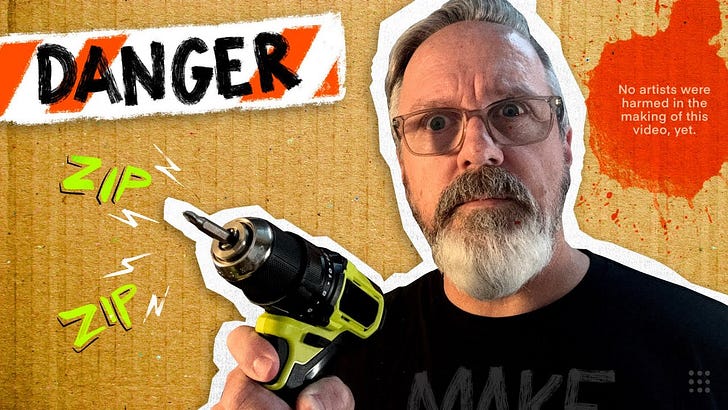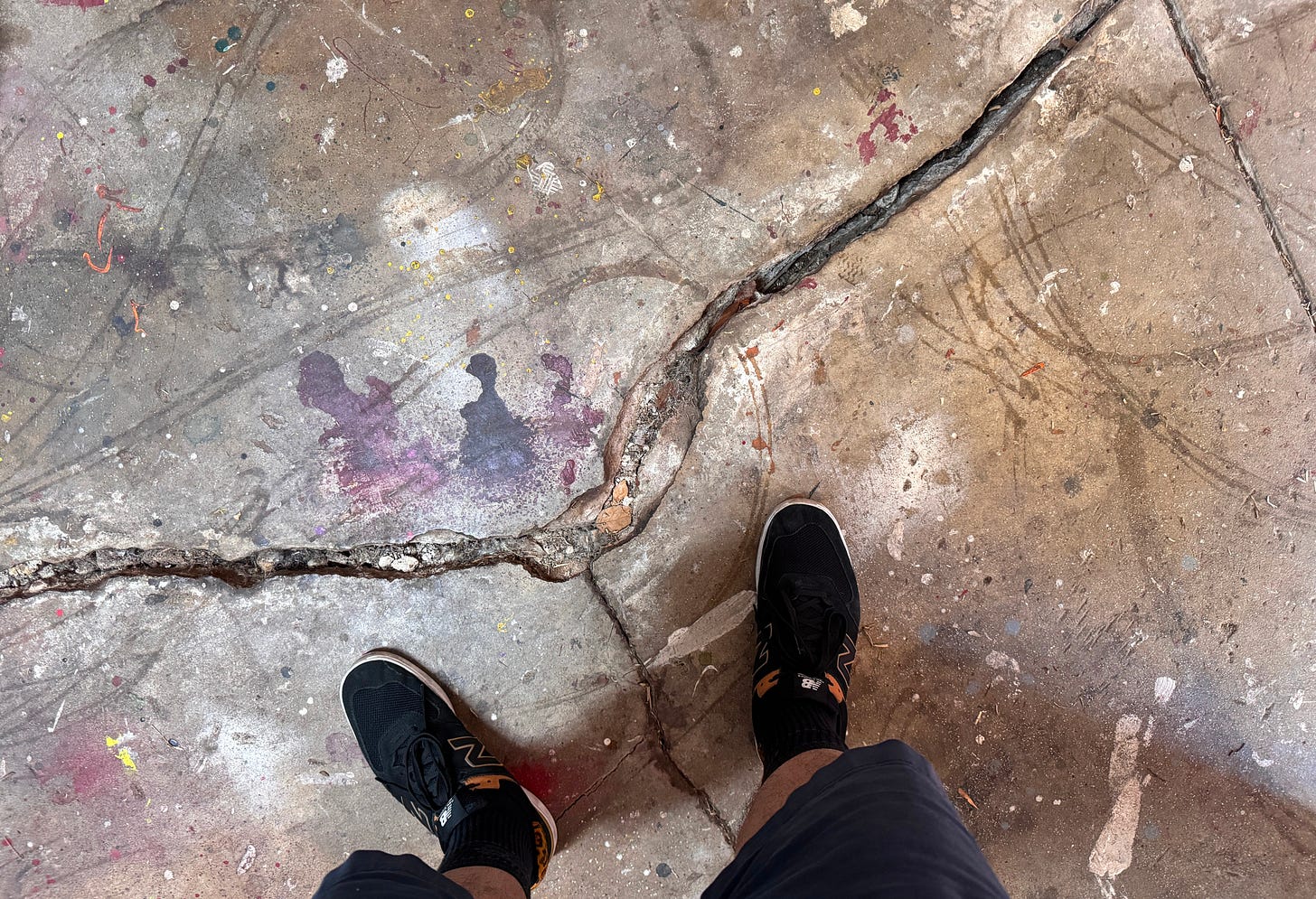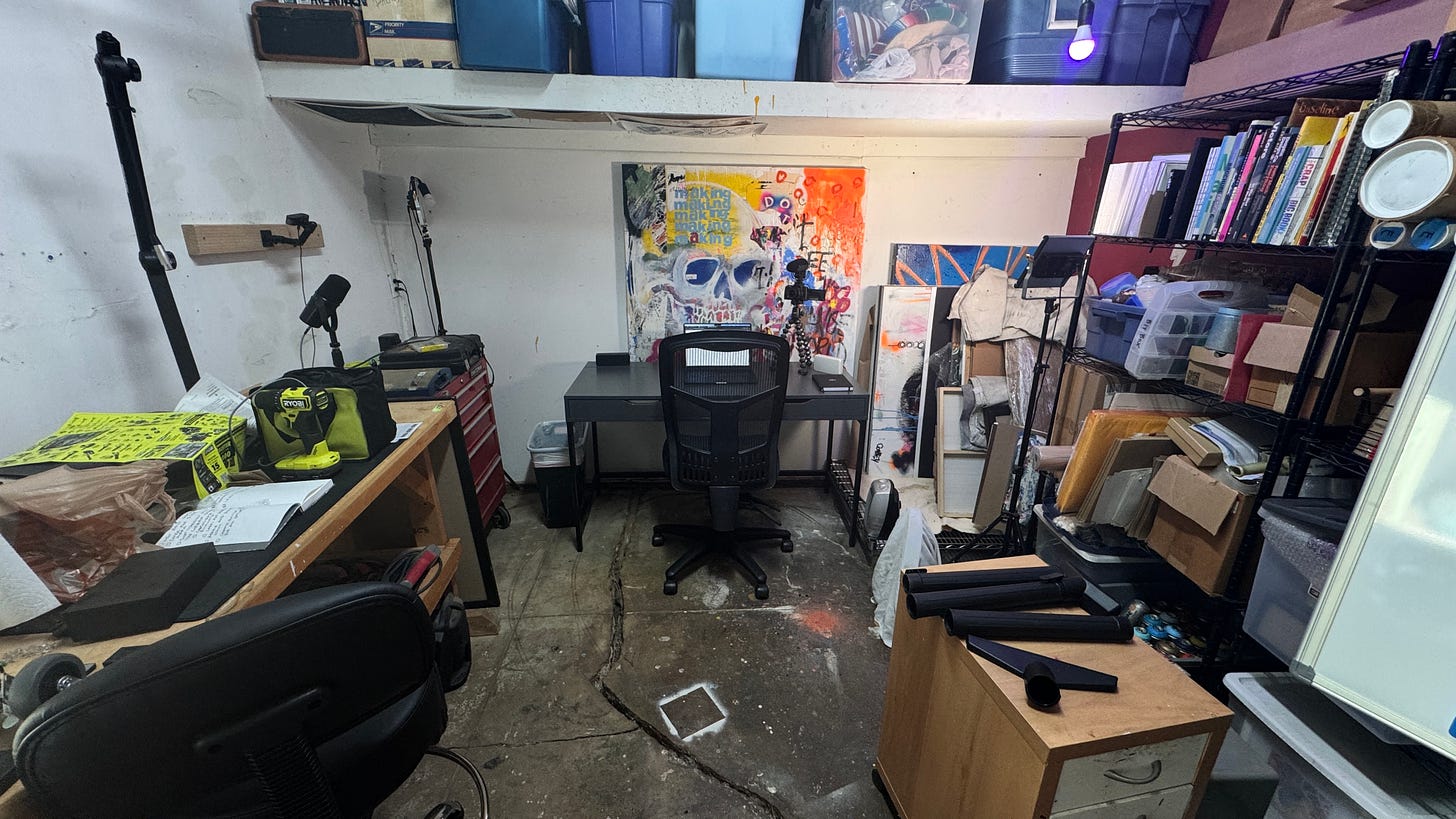When my wife and I moved into our 1920s Craftsman home, I didn’t intend to turn my garage into a partial art studio. I actually used it to store my Harley Davidson and all the extra junk that didn’t fit in the house. At that time, I painted inside the home, but after I splashed one too many paint daubs on the walls and hardwood floors, my wife implored me to stop and relegated my sloppiness outside.
That was nearly fourteen years ago, and since then, The Shed (my affectionate name for the garage/studio) has undergone a few transformations to accommodate both my art and home storage needs, and it’s been a sufficient space for creating, but never felt great.
Over the years, I’ve complained a lot about this space. It’s cold in the winter, hot in the summer, and often dusty because the doors have gaps due to time and a sinking foundation. Those gaps also allow critters to enter, and I’ve caught mice and small possums in the space many times.
Oh, did I also mention there’s a giant crack that runs down the entire length of the cement floor? Not only does it threaten the integrity of the entire structure, but it’s also annoying because the wheels of my desk chair keep getting caught in it.
The floors are slanted, the lighting isn’t great, and although the garage is rectangular, the current layout isn’t great for what I need. Although I’ve tried to adapt a few times over the years, I’m continuously compensating for one or more of my needs, usually sacrificing work space for storage.
Now that I’ve moved into my dowhateverthefuckiwantist era, I’ll be experimenting with a wide variety of creative projects, including filming videos and having a space to write. So, it’s time to reimagine The Shed in a way that caters to those creative impulses instead of compensates for them.
No more complaints
While researching how to turn The Shed into a highly functional space, I found myself going down a rabbit hole of artists sharing their studio space, many of whom have nothing more than a small corner of their apartment to work in, but they make use of every square inch of that corner.
Meanwhile, I have over nearly 190 sq. ft. of available space, plus a lot of empty walls that can be rethought to make the studio the most creatively functional third space possible. So, no more crying from me because I am fortunate, and I now see it as my responsibility to make this space epically awesome for the sake of all creatives everywhere.
But where do I start?
Planning is the answer, and my designer brain is battling with my artist brain to figure out what I’ll do with the available space. The most challenging part is thinking in cubes instead of squares.
I started creating a floor plan, and I have a good idea of where things should go. However, while imagining the placement of my desk, workbench, and tool chests, I must consider what should take up the walls near them.
I’ve never used the Shed walls much except to hold up my art, which is nice but also a bit wasteful. I still want space on the walls for my art and creative projects, but how can I do it better?
There’s also space above in the rafters, but if I put more stuff up there, then I’ll need to rethink the lighting. The main light in the Shed is a fluorescent shop lamp that illuminates the space well and is only mildly distracting when trying to type up an article about how to rethink my studio. I
Yeah, I know—first-world homeowner problems.
Big ideas are scary AF!
One hundred ninety square feet of floor space and nearly that much in wall space is a lot to fill. Trying to imagine how it would all work now would be difficult even if I knew precisely the type of work I’d be doing. I have a general idea of the projects I want to work on, but even with some of the wild pipe dreams kicking around in my head at the moment, I can’t imagine what I’m going to need in the future.
I’m not going to worry about it.
Instead, I’m looking at everything that happens in The Shed as a modular project. I want things in the space to be movable, flexible, and easy to build upon while also allowing for fun and freedom to display art and other things that inspire me.
“The shop that works best is the shop that is sculpted to the proclivities of the maker that is using that shop.” - Adam Savage
It’s also essential to have the right tools and equipment with easy reach, so I don’t have to go digging through shelves and drawers to find them. Hammers are good on a wall, and not in a bag—that’s just dumb.
I still imagine plenty of shelves, pulleys, workspaces on hinges, and mason jars attached by the lid to an overhead platform for easy storage of screws, nails, rubber bands, doodads, and nuts, preferably cashews.
For my video production needs, I want sound deadening, warm LED lighting, and one of those dark gray walls that hold an obscure phrase written in neon to keep people guessing. Oh, and house plants—definitely need a ficus or something.
Of course, if I make all these shelves and spaces, then I’ll need to fill them with things, so I’ll need to make things, which means more tools, and then I’ll need space for the tools. It’s becoming obvious to me why so many of my craftiest friends have walls filled with tools they’ll only use once but display proudly like trophies.
Thinking about it all now is overwhelming, and if I waited until I had it all figured out, I wouldn’t get any of it done. Instead, I’m taking it one project at a time, working and building as needed, and if I need to reconfigure part of the space at some point, I’ll do that.
But for now, it’s time to do something about the damn crack.








The one thing I miss in our move from America to Prague is a dedicated studio space. It’s the couch for me now.
Your video is very funny even though you have a heavy project ahead.